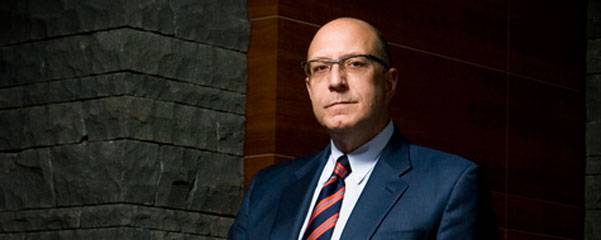Corporate Communications in the Age of Facebook
Panelists discuss the social media revolution in the Center for Digital Strategies' latest Britt Technology Impact Series event.

Social media is a revolution, not a fad, and corporations avoid it at their own peril. This maxim became clear during the recent panel discussion, “Corp Comm in the Age of Facebook,” the latest in the Center for Digital Strategies’ Britt Technology Impact Series.
Moderated by corporate communications professor Paul Argenti, the panel on May 9 included Rod Thorn, director of communications at PepsiCo; Alex Dudley, vice president of public relations at Time Warner Cable Inc.; Paul Dickard, vice president of external communications at AECOM; and Ray Kerins, vice president of external affairs and worldwide communications at Pfizer Inc.
Argenti began the discussion by noting that social media has caused the “democratization of content.” The anecdotes from the panel bore his theory out, with the speakers agreeing that it’s impossible for corporations to control their messages in today’s social media landscape. The best a corporation can do, they said, is to be responsive to its customers and add its voice to the millions already chatting, with the hope that the company’s character and authenticity come through.
Thorn explained how PepsiCo recently embraced this reality during the product development process. “We decided that we’re not going to be a company that sits back and creates products and says, ‘You will have them,’” he said. Instead Pepsi used social media—through the “Dewmocracy” campaign—to solicit flavor, name, packaging, and advertising ideas for new versions of Mountain Dew. And after a product is launched, he explained, the customers still own much of the discussion, since research has shown that people trust their friends and family much more than they trust corporate advertising. One way Pepsi capitalizes on this is by giving its employees e-postcards to send to friends, so they can correct public misconceptions or amplify a piece of the corporate persona that’s not being heard.
For a corporation like Pfizer that’s heavily regulated by the government, the role of social media is a little more nuanced. Since it can only say certain statements about its products, Kerins explained that Pfizer is using social media to talk about corporate social responsibility, disseminate public information, and promote its image as a firm that, at the end of the day, just wants to create medicine that makes people feel better. And it turns out that social media is one way to improve its products: “We’re looking for complaints,” he said, referring to “adverse events,” or occasions when a patient has a problem with a medication. Pfizer benefits from that information, and the Internet is the conduit. “We’re trying to get a greater dialogue with patients,” he said, “and we’re using social media like we never have before.”
The panelists also agreed that social media has become a valuable tool for communicating during crises. Before Paul Dickard began his current position, he worked for Ingersoll Rand, which manufactures Kryptonite bicycle locks. When a video appeared online instructing people how to pick its U-locks with a Bic pen, it soon went viral and the company had a communications disaster on its hands. It tried the traditional stop-gap measure—a press release—but that had virtually no effect on the thousands of people running the company’s name through the mud. Then a company employee decided to start a Kryptonite blog to manage the issue and engage with the cyclist community. Cyclists responded favorably, and the blog bought the company time to develop a solution.
Pfizer was able to use social media to get in front of a potential crisis—when it recalled its popular drug Lipitor because the bottles had a strange smell. “We knew all the things we were going to be asked about,” he said, “so we wanted to hit it head on.” In this case, using social media was not about controlling a message or an identity, but getting the right information into customers’ hands.
Yet, there’s “nothing worse than watching a company try to build a social media presence when things are going wrong,” said Dudley. The conditions will never be perfect for a corporation’s first foray into Twitter or Facebook, so Dudley advised the audience to be comfortable with a little risk in the transition. The way to minimize it, he said, is to bring in outside perspectives and understand that implementing social media requires a manager who has lived and breathed it. Dudley did this when he hired a gentleman who had created a popular blog about lesbian, gay, bisexual, and transgender issues. “He was the antithesis of a cable executive,” he said, showing up to work the first day in a three-piece suit and Chuck Taylor sneakers. “But he provided a voice for us that would have been painful for us to create from within.”
Dudley added, “I would not hire someone today who didn’t get that this is not a fad.”
May 2011